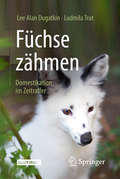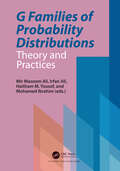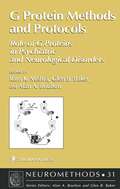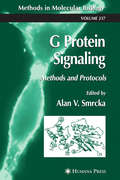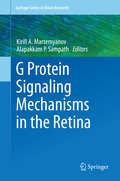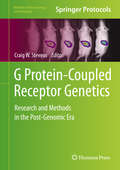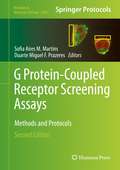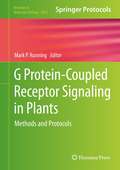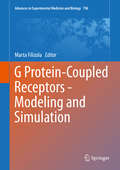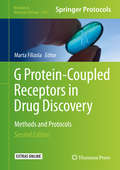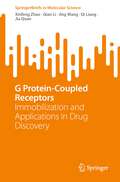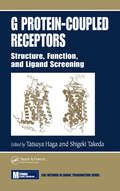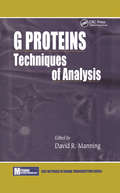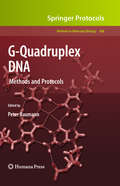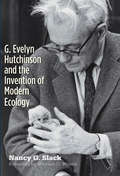- Table View
- List View
Física de lo imposible: ¿Podremos ser invisibles, viajar en el tiempo y teletransportarnos?
by Michio Kaku¿Hasta qué punto los ingenios de la ciencia ficción que hoy consideramos imposibles pueden ser habituales en el futuro? Teletransporte, máquinas del tiempo, campos de fuerza y naves intergalácticas: ¿materia de ciencia ficción o tecnologías potencialmente disponibles en el futuro? Inspirado por los mundos fantásticos de H.G. Wells, Star Trek o La guerra de las galaxias, el prestigioso físico teórico y divulgador Michio Kaku lanza una mirada inteligente, seria y a menudo sorprendente a lo que nuestra actual comprensión de las leyes del universo nos permite vislumbrar en el futuro. Un fascinante viaje por mundos hasta ahora solo soñados por la ciencia ficción, que ofrece nuevos retos a las próximas generaciones de científicos capaces de desafiar las imposibilidades de nuestro tiempo. Reseñas:«Física de lo imposible trata de explicar por qué algunas visiones del futuro podrían llegar a realizarse mientras que otras probablemente permanecerán más allá de los límites de lo posible [...] La ciencia ficción explora a menudo estas cuestiones; la ciencia en cambio permanece callada en este punto. El trabajo de Kaku ayuda a llenar un vacío.»The Economist «Aquello que muchos consideran un vuelo de la imaginación se está materializando gracias a recientes descubrimientos científicos, que van desde tímidos progresos en teletransporte hasta la creación de pequeñas cantidades de antimateria y transmisiones más rápidas que la velocidad de la luz. Kaku demuestra que en los maravillosos mundos de la ciencia las cosas imposibles suceden a diario.»Publishers Weekly «Pocos físicos teóricos se plantearían explorar algunas de estas posibles imposibilidades, y hay que felicitar a Kaku por hacerlo. Es un excelente estímulo intelectual.»Los Angeles Times
Fósiles del cosmos
by Paula Jofré PfeilUna importante contribución a la ciencia astronómica. Un viaje que comienza con la composición química de nuestra galaxia y que, a través de la misión espacial GAIA, nos muestra la forma en que ha evolucionado el universo. La astronomía ha logrado llevar a cabo, nos dice Paula Jofré en este libro, un progreso sin parangón en los últimos años. La misión espacial GAIA, punta de lanza del programa científico de la Agencia Espacial Europea, ha posibilitado el acceso a información de incalculable valor: el lugar y la distribución de millones de estrellas que conforman nuestra galaxia. La ciencia galáctica, compuesta por conocimientos tan distintos como la física nuclear, la estadística, la astrofísica y la inteligencia artificial, entre otras áreas del saber, ha posibilitado un proyecto interdisciplinario fundamental para entender los datos que GAIA, desde el espacio, puede ofrecer. En Fósiles del cosmos, la autora nos introduce tanto en la astronomía, como en la composición química estelar, en el funcionamiento de las estrellas, la posición de las estrellas en el cielo, en las historias de las científicas que han hecho historia en esta área del saber y, sobre todo, nos enseña a leer y comprender los mapas y datos que la misión espacial envía a la Tierra, ofreciendo una nueva manera de comprensión del cosmos y, sobre todo, la posición que ocupamos en este. De esta forma se puede explicar, de manera certera, la formación y evolución de la Vía Láctea, nuestra galaxia…
Füchse zähmen
by Lee Alan Dugatkin Jorunn Wissmann Ludmila TrutAn einem Ort im abgelegenen Sibirien findet man vierbeinige Fellwesen, die mit dem Schwanz wedeln, Schlappohren haben und so gelehrig und freundlich sind wie Schoßhunde. Doch es sind keine Hunde – es sind Füchse. Sie sind das Ergebnis eines der erstaunlichsten Züchtungsexperimente, die je unternommen wurden – stellen Sie sich einmal vor, die Evolution mehrerer Jahrtausende sei auf einen Zeitraum weniger Jahrzehnte beschleunigt. Im Jahre 1959 nahmen sich die Biologen Dmitri Beljajew und Ludmila Trut genau dies vor, indem sie mit ein paar Dutzend Silberfüchsen von Pelzfarmen in der damaligen UdSSR begannen und mit ihnen die Entwicklung vom Wolf zum Hund in Echtzeit nachzuvollziehen versuchten, um so den Prozess der Domestikation direkt zu beobachten. Das vorliegende Buch erzählt die bisher weitgehend unbekannte Geschichte dieses bemerkenswerten Unterfangens. Die meisten Berichte über die natürliche Evolution des Wolfes legen dem Domestikationsprozess eine Zeitspanne von 15.000 Jahren zugrunde, aber aus Beljajews und Truts Züchtungsexperimenten gingen schon innerhalb eines Jahrzehnts welpenähnliche Füchse mit Schlappohren, gesprenkelten Fellen und gebogenen Schwänze hervor. Begleitet wurden diese physischen Veränderungen von genetischen und Verhaltens-Modifikationen. Für die Züchtung der Füchse war Zahmheit das entscheidende Selektionskriterium, und mit jeder Generation zeigten die Tiere ein zunehmend größeres Interesse an der Gemeinschaft mit Menschen. Trut ist seit Anfang an bei diesen Experimenten dabei, und nach Beljajews Tod im Jahre 1985 übernahm sie die Leitung. Zusammen mit dem Biologen und Wissenschaftsautor Lee Dugatkin erzählt sie hier nun die Geschichte dieses Abenteuers und der Wissenschaft, Politik und Liebe dahinter. In Füchse zähmen nehmen uns Dugatkin und Trut mit auf die Innenseite dieses bahnbrechenden Experiments inmitten der brutalen sibirischen Winter und legen offen, wie Wissenschaftsgeschichte gemacht wird – bis heute. Inzwischen sind 58 Generationen von Füchsen domestiziert, und immer noch lernen wir von ihnen bedeutsame Dinge über die genetische und verhaltensbiologische Evolution domestizierter Tiere. Füchse zähmen bietet eine oft unglaubliche Geschichte von Wissenschaftlern bei der Arbeit und ist zugleich eine Hommage an die tiefen Bande, die Tiere und Menschen über alle Zeiten hinweg entwickelt haben. Stimmen zur amerikanischen Originalausgabe Vor über 60 Jahren entschlossen sich die russischen Forscher [Ludmila] Trut und Dmitri Beljajew, wilde Füchse zu domestizieren, um im Detail herauszufinden, wie die Reise vom Wildtier zum Haustier abläuft. Sie setzten ihr Experiment in einer Pelzfarm in Sibirien auf und wählten über die folgenden Jahrzehnte stets die zahmsten Tiere jeder Generation für die weitere Fortpflanzung aus. In diesem Buch zeichnen der Biologe und Wissenschaftsautor Dugatkin und Trut die Geschichte dieses großartigen Experiments nach. Das Ergebnis sind eine Schar gelehriger Füchse und die Entschlüsselung der genetischen Grundlagen ihrer Domestikation. Scientific American Schillernd … Eine Geschichte, die teils Wissenschaft, teils russisches Märchen, teils Spionagethriller ist … Die Ergebnisse sind selbst unter Wissenschaftlern, geschweige denn in der Öffentlichkeit, viel weniger bekannt, als sie es verdient haben. New York Times Dugatkin ist ein sehr erfahrener Wissenschaftsautor mit der besonderen Gabe, vielfach verzweigte Themen in kompakte, unterhaltsame Geschichten zu verwandeln. Frau Trut, inzwischen in ihren Achtzigern, ist gleichermaßen Coautorin und Gegenstand des Buches … ihre intensive Mitwirkung verleiht diesem Wissenschaftsbericht eine seltene Form der Intimität. Wall Street Journal Ein zauberhafter Bericht … Nach etwa 20 Generationen wurden die gezähmten Füchse immer mehr wie Hunde: loyal und unschlagbar niedlich. New Scientist Voller Zuneigung erzählen uns Trut und Dugatkin von den Meilensteinen des Experiments, von dem ersten neugeborenen Fuchs, der mit dem Schwanz wedelte, und von dem ersten mit Schlappohren … Bei jedem Schritt verweben die Autoren in geschickter W
Fügetechnologie Kleben: eine Anleitung für den zeitgemässen und sicheren Klebprozess in Industrie und Handwerk
by Jürgen KlingenKleben gehört zu den wärmearmen Fügetechniken und ist in der Lage, praktisch alle technisch nutzbaren Werkstoffe miteinander und untereinander flächig und stoffschlüssig zu verbinden. Die hierbei durch Adhäsion entstehende Verbindung wird sehr schonend aufgebaut, da der Klebvorgang weder großer Hitze (wie beim Schweißen oder Löten), noch strukturschwächende Löcher (wie beim Nieten oder Schrauben) bedarf. Die in der Regel großflächig ausgelegte Klebung sorgt zudem für eine relativ gleichmäßige Spannungsverteilung im Bauteil. In einem klar strukturierten 5-Phasensystem bietet Fügetechnologie Kleben hier eine detaillierte Anleitung für die Schritte, die für den Aufbau eines sicheren und stabilen Klebprozesses zur Herstellung eines qualitativ hochwertigen Bauteils notwendig sind. Berücksichtigt werden dabei unter anderem die Vorbehandlung der zu verklebenden Werkstoff oberflächen, die Auswahl der geeigneten Klebstoffe, die Dimensionierung der Verklebung sowie die Prozessschritte zur Dosierung beziehungsweise Aushärtung der Klebstoffe. Dem Anwender werden so moderne und nachhaltige Materialien sowie klebtechnische Verfahren präsentiert, mit einem besonderen Fokus auf Oberflächenbehandlungsmöglichkeiten, Klebstoffe und Verarbeitungsmethoden relevant für Industrie und Handwerk.
Führung und Organisation pharmazeutischer Innovation: Wie man den Wettlauf der Life Sciences gewinnt
by Alexander Schuhmacher Oliver Gassmann Gerrit Reepmeyer Max von ZedtwitzDieses Buch untersucht und beleuchtet die wichtigsten Herausforderungen, denen sich die pharmazeutische Industrie in einem zunehmend wettbewerbsorientierten Umfeld mit inflationären F&E-Investitionen und verschärftem Kostendruck stellen muss. Die Autoren stellen drei Quellen der pharmazeutischen Innovation vor: neue Managementmethoden in der Arzneimittelentwicklung, neue Technologien als Voraussetzung für Spitzenforschung und -entwicklung und neue Formen der Zusammenarbeit und Internationalisierung, wie z. B. Open Innovation in den frühen Phasen der Forschung und Entwicklung. Neue Modelle und Methoden werden anhand von Fallbeispielen aus Europa, den USA und Asien illustriert. Diese dritte, vollständig überarbeitete Auflage wurde erweitert, um die neuesten Entwicklungen im Bereich der offenen und kollaborativen Innovation, die größere strategische Bedeutung von Risikokapital und Investitionen in der Frühphase sowie die neue Palette an aufkommenden Technologien, die jetzt in der pharmazeutischen Innovation eingesetzt werden, zu berücksichtigen.
Für alles eine App: Ideen für Physik mit dem Smartphone
by Jochen Kuhn Thomas WilhelmFür alles eine AppWelche Apps eignen sich, um Smartphone oder Tablet für physikalische Untersuchungen und Betrachtungen zu nutzen? Diese Frage stellen sich physikalisch Interessierte genauso wie Lehrkräfte. Dieses Buch gibt einen schnellen und umfassenden Überblick über geeignete Apps und stellt anhand vieler Praxisbeispiele dar, wie man Smartphone und Tablet physikalisch nutzen kann.Die Autorinnen und Autoren gehen auf unterschiedlichste Anwendungen ein: Sie reichen von vorgefertigten Simulationen über physikalische Spiele bis hin zu Augmented Reality-Anwendungen, bei denen virtuelle Objekte in das Bild der realen Welt eingeblendet werden. Zudem werden Apps vorgestellt, mit denen Messdaten mit den internen Sensoren oder externen Zusatzgeräten erfasst, von einer Datenbank abgerufen oder durch die Verwendung der Foto- und Videokamera gewonnen werden.In jedem einzelnen Abschnitt wird eine andere App kurz und überblicksweise vorgestellt und deren Verwendbarkeit für physikalische Untersuchungen in Schule und/oder Hochschule und/oder zur eigenen Unterhaltung an einem Beispiel erläutert. Zunächst gibt es eine App-Kurzbeschreibung und Informationen zu Technik und Handhabung. Es folgt die Beschreibung eines physikalischen Anwendungsbeispiels. Die Abschnitte sind nach klassischen Themenbereichen der Physik geordnet.Die Leserinnen und Leser werden nach der Lektüre• einen Überblick haben, welche vielfältigen physikalischen Anwendungen mit mobilen Geräten möglich sind,• viele verschiedene Apps kennengelernt haben,• zu physikalischen Spielereien mit mobilen Geräten motiviert sein,• Anregungen kennen, wie man mobile Endgeräte in der physikalischen Lehre einsetzen kann.
G Families of Probability Distributions: Theory and Practices
by Mohamed Ibrahim Mir Masoom Ali Irfan Ali Haitham M. YousofStatistical distributions are essential tools to model the characteristics of datasets, such as right or left skewness, bi-modality or multi-modality observed in different applied sciences, such as engineering, medicine, and finance. The well-known distributions like normal, Weibull, gamma and Lindley are extensively used because of their simple forms and identifiability properties. In the last decade, researchers have focused on the more complex and flexible distributions, referred to as Generalized or simply G families of probability distributions, to increase the modelling capability of these distributions by adding one or more shape parameters.The main aim of this edited book is to present new contributions by researchers in the field of G families of probability distributions. The book will help researchers to: Develop new univariate continuous and discrete G families of probability distributions. Develop new bivariate continuous and discrete G families of probability distributions. Derive beneficial mathematical properties such as ordinary and incomplete moments, moment generating functions, residual life and reversed residual life functions, order statistics, quantile spread ordering and entropies, and some bivariate and multivariate extensions of the new and existing models using a simple-type copula.
G Protein Methods and Protocols
by Alan A. Boulton Glen B. Baker Ram K. MishraCombining the cutting-edge insights of leading basic and clinical investigators, G Protein Methods and Protocols provides both critical reviews and detailed protocols for studying the medical role played by G proteins and cellular signaling in psychiatric and neurological disease. The mental and neurological disorders covered range from Parkinson's disease and schizophrenia to manic depression, drug addiction, and mood and anxiety disorders.
G Protein Signaling
by Alan V. SmrckaA collection of cutting-edge methods for investigating G protein signaling from a variety of perspectives ranging from in vitro biochemistry to whole animal studies. Among the readily reproducible techniques presented are those for the purification of G proteins and effectors enzymes, assays of these purified G proteins and effector enzymes, and for the study of G proteins interactions with effectors in intact cells. Additional methods are provided for assaying G protein coupled receptor structure, function, and localization; for studying the physiological roles for endogenous G proteins; and for examining lipid and phosphate modifications of RGS proteins.
G Protein Signaling Mechanisms in the Retina
by Kirill A. Martemyanov Alapakkam P. SampathThe main purpose of this volume is to provide a focused analysis of the function of the G protein-coupled signaling pathways that operate in the interconnected network of retinal neurons as they detect and encode the information carried by light. The organization of this volume will generally follow the path of signal flow in the retina. First we will describe recent advances in understanding the phototransduction cascade of rod and cone photoreceptors, which use signaling cascade based on the GPCR rhodopsin to transduce incident light into neural activity Chapters will be devoted to unique specializations of the two major types of photosensitive cells that comprise the predominant input for our spatial and color vision Subsequently, the mechanisms of synaptic information encoding by retinal ON bipolar cells will be described, where the GPCR mGluR6 plays a fundamental role Chapters in this section will examine macromolecular organization of the mGluR6 signaling pathway as well as current understanding of its function. The functional characteristics of this signaling mechanism will be explored in detail. Additionally, this section will cover the role of dopamine receptors in modulating signal transmission between photoreceptors and ON-bipolar cells. Finally, chapters will be focused on the output neurons of the inner retina, ganglion cells, where the components of the emerging GPCR melanopsin cascade in intrinsically photosensitive ganglion cells will be detailed. Collectively these mechanisms allow the retina to represent visual space over a wide range of light intensities.
G Protein-Coupled Receptor Genetics
by Craig W. Stevens"G Protein"" ""Coupled Receptor Genetics: Research and Methods in the Post"" ""Genomic Era" features practical techniques inspired by the fast moving GPCR field. From powerful bioinformatic tools tracing the evolution of GPCRs, to methods for the cellular transfection of engineered viruses containing GPCRs, to optogenetic techniques that produce light-activated GPCRs in live mice, what was once science fiction is now science fact. This detailed volume includes sections covering genetic mechanisms, a genetic toolbox for GPCR discovery, as well as genetic aspects of G protein-coupled receptors in health and medicine. Written for the "Methods in Pharmacology and Toxicology" series, this book contains the kind of key implementation advice that encourages successful results in the lab. Authoritative and easy to use, "G Protein"" ""Coupled Receptor Genetics: Research and Methods in the Post"" ""Genomic Era" serves as an ideal guide for researchers aiming to continue our progress in this dynamic and exciting area of study. "
G Protein-Coupled Receptor Kinases
by Vsevolod V. Gurevich Eugenia V. Gurevich John J.G. TesmerThis collection explores up-to-date descriptions of known G protein-coupled receptor kinase (GRK)-dependent mechanisms, both associated with G protein-coupled receptor (GPCR) functions and the receptor-independent. The chapters cover a wide range of studies from invertebrates to humans, with sections of the volume covering GRK structure, mechanisms of activation, and interaction with GPCRs, GRKs in cell signaling, as well as physiological and pathophysiological mechanisms regulated by GRKs. Written for the "Methods in Pharmacology and Toxicology" series, this book features the kind of practical detail necessary for success in the laboratory. Authoritative and timely, "G Protein-Coupled Receptor Kinases" features the kind of comprehensive mechanistic elucidation of GRK functions and their regulation in cells necessary for a better understanding of cell biology as well as for devising novel research approaches and therapeutic strategies.
G Protein-Coupled Receptor Screening Assays: Methods and Protocols (Methods in Molecular Biology #2268)
by Duarte Miguel F. Prazeres Sofia Aires M. MartinsThis fully updated edition targets not only those assays directly involved in the discovery of GPCR-active compounds but also those involved in cell-based experiments designed to study physiological responses. Whether coming from academia or industry, or being an experienced researcher or a newcomer to the field, the reader will find accessible methods and protocols that cover the latest developments on receptor purification, molecular biology, recombinant engineering, and analytical techniques that enable the real time monitoring of the complex GPCR signaling cascade and identification of potential drug targets. Written for the highly successful Methods in Molecular Biology series, chapters include introductions to their respective topics, lists of the necessary materials and reagents, step-by-step, readily reproducible laboratory protocols, and tips on troubleshooting and avoiding known pitfalls. Authoritative and up-to-date, G Protein-Coupled Receptor Screening Assays: Methods and Protocols, Second Edition aims to provide the tools necessary to contribute to the advancement of GPCR research and discovery and ultimately lead to the availability of innovative and more efficient drugs.
G Protein-Coupled Receptor Signaling in Plants: Methods and Protocols
by Mark P. RunningRemarkably, while G protein-coupled receptors (GPCRs) are highly prevalent in animals and yeast, very few candidate GPCRs have been identified in plants. In G Protein-Coupled Receptor Signaling in Plants: Methods and Protocols, experts in the field describe techniques used in the study of small GTPases and related proteins. Beginning with a chapter on bioinformatics approaches for GPCR discovery, this detailed volume continues with chapters on heterotrimeric G protein subunits, Rab-GTPases, as well as lipid modifications, including myristoylation, acylation, and prenylation. Written in the highly successful Methods in Molecular Biology series format, chapters include introductions to their respective topics, lists of the necessary materials and reagents, step-by-step, readily reproducible laboratory protocols, and tips on troubleshooting and avoiding known pitfalls. Practical and dependable, G Protein-Coupled Receptor Signaling in Plants: Methods and Protocols aims to aid further studies into the roles of small GTPases which will help elucidate numerous key processes in plants.
G Protein-Coupled Receptors - Modeling and Simulation
by Marta FilizolaG protein-coupled receptors (GPCRs) are heptahelical transmembrane receptors that convert extra-cellular stimuli into intra-cellular signaling, and ultimately into biological responses. Since GPCRs are natural targets for approximately 40% of all modern medicines, it is not surprising that they have been the subject of intense research. Notwithstanding the amount of data generated over the years, discovering ligands of these receptors with optimal therapeutic properties is not straightforward and has certainly been hampered for years by the lack of high-resolution structural information about these receptors. Luckily, there has been a steady increase of high-resolution crystal structures of these receptors since 2007, and this information, integrated with dynamic inferences from computational and experimental methods, holds great potential for the discovery of new, improved drugs. This book, which provides, for the first time, state-of-the-art views on modeling and simulation of GPCRs, is divided into 4 parts. In the first part, the impact of currently available GPCR crystal structures on structural modeling is discussed extensively as are critical insights from simulations in the second part of the book. The third part reports recent progress in rational ligand discovery and mathematical modeling, whereas the fourth part provides an overview of bioinformatics tools and resources that are available for GPCRs.
G Protein-Coupled Receptors in Drug Discovery
by Kenneth H. Lundstrom Mark L. ChiuThe broad range of G protein-coupled receptors (GPCRs) encompasses all areas of modern medicine and have an enormous impact on the process of drug development. Using disease-oriented methods to cover everything from screening to expression and crystallization, G Protein-Coupled Receptors in Drug Discovery describes the physiological roles of GPCRs
G Protein-Coupled Receptors in Drug Discovery
by Marta FilizolaThis detailed volume provides an overview of recent techniques employed in the field of G protein-coupled receptors (GPCRs) to screen for new drugs and to derive information about their receptor structure, dynamics, and function for the purpose of developing improved therapeutics. Owing to remarkable recent advances in the structural, biophysical, and biochemical analyses of these receptors, as well as a growing body of evidence hinting at the possible relevance of allosteric modulators, biased agonists, and oligomer-selective ligands as improved therapeutic agents, drug discovery for GPCRs has recently taken a completely new direction. For this book, expert contributors have shared their protocols and views on the impact of these methodologies on modern drug discovery. Written for the highly successful Methods in Molecular Biology series, chapters include introductions to their respective topics, lists of the necessary materials and reagents, step-by-step, readily reproducible laboratory protocols, and tips on troubleshooting and avoiding known pitfalls. Practical and fully updated, G Protein-Coupled Receptors in Drug Discovery: Methods and Protocols, Second Edition serves as an ideal guide for a diverse audience from structural and molecular biologists to pharmacologists and drug designers who wish to explore this extensive class of key drug targets. --
G Protein-Coupled Receptors: Immobilization and Applications in Drug Discovery (SpringerBriefs in Molecular Science)
by Jing Wang Qian Li Xinfeng Zhao Qi Liang Jia QuanThis book summarizes the progress made to functional immobilize G protein-coupled receptors (GPCRs) through site-specific or orientated recognition in both non-covalent and covalent manners. The last decade is the dawn of the “post-structural biology” era for G protein-coupled receptor research. As an emerging approach for state-of-the-art immobilization, this book discusses efforts to explore the elegance of naturally-occurring biochemical reactions by using their high specificity and robust reactivity in the complex system, such as site-specific conjugation by covalent recognition between enzymes and their substrates. With the perspective of protein-drug interactions, this book also reviews the applications of protein immobilization, with an emphasis on G protein-coupled receptors, in drug discovery and protein-ligand interaction analysis. In addition, the merits, opportunities and disadvantages are analyzed for different immobilization methods, and a perspective for future directions is presented. Given its scope, this book appeals to a broad readership, particularly researchers engaged in the field of analytical chemistry, bioconjugate chemistry, and chemical biology, and other related field, as well as teachers of relevant majors in colleges and universities.
G Protein-Coupled Receptors: Structure, Function, And Ligand Screening (Methods in Signal Transduction Series)
by Tatsuya Haga Gabriel BersteinCovering recently developed methods in membrane-bound receptors, this book emphasizes receptor structure and function, knowledge of which is essential to the study of signal transduction.G Protein-Coupled Receptors has culled contributors from domestic and international sources, providing a broad base of knowledge. Some topics covered are the r
G Protein-Coupled Receptors: Structure, Function, and Ligand Screening
by Tatsuya Haga Shigeki TakedaThis book provides a broad base of knowledge of G-protein-coupled receptors. Useful at both the university and industrial levels, this book is of particular interest to those who are developing therapeutic approaches to diseases using drugs that influence receptor activation.
G ProteinsTechniques of Analysis (Methods in Signal Transduction Series)
by David R. ManningIncorporating a bench-top format, G Proteins: Techniques of Analysis covers essential methods - with a commitment to those techniques of proven and current utility. It offers an in-depth description of protocols, together with theory and representative data. It includes expression and functional analysis of G proteins; evaluation of covalent modifications and other regulatory phenomena; and, mapping pathways established among receptors, G proteins, and effectors. Incorporating contributors from key institutions, each contributor offers clear instructions to establish a synthesized, concise and consistent approach to each chapter, which is beneficial to both students and professionals.
G-Quadruplex DNA
by Peter BaumannRecent work has revealed that stabilizing G-quadruplexes in telomeric DNA inhibits telomerase activity, providing impetus for the development of G-quartet-interacting drugs, while G-quartet-containing oligonucleotides have been recognized as a potent class of aptamers effective against STAT3 and other transcription factors implicated in oncogenesis, proving these guanine-quartets to be a vital and rich area for future study. In "G-Quadruplex DNA: Methods and Protocols", experts in the field present a collection of detailed techniques for studying G-quartet formation, dynamics, and molecular recognition. Written in the highly successful Methods in Molecular BiologyTM series format, chapters include brief introductions to their respective topics, lists of the necessary materials and reagents, step-by-step, readily reproducible laboratory protocols, and notes on troubleshooting and avoiding known pitfalls. Authoritative and cutting-edge, "G-Quadruplex DNA: Methods and Protocols "promises to be a useful resource for those familiar with G-quartets as well as an easy entry point for those researchers from diverse fields who are just developing an interest in the exciting implications of G-quadruplex DNA.
G-Quadruplex Nucleic Acids: Methods and Protocols (Methods in Molecular Biology #2035)
by Danzhou Yang Clement LinThis volume covers the structures, properties, and functions of G-quadruplexes in a wide range of biological disciplines, including therapeutic intervention and biomaterial application. The chapters in this book explore a wide range of vital and new experimental techniques used in the study of G-quadruplexes. Written in the highly successful Methods in Molecular Biology series format, chapters include introductions to their respective topics, lists of the necessary materials and reagents, step-by-step, readily reproducible laboratory protocols, and tips on troubleshooting and avoiding known pitfalls. Practical and cutting-edge, G-Quadruplex DNA: Methods and Protocols is a valuable resource for both novice and experienced researchers who work in biophysics, structural biology, computational biology, biochemistry, and molecular and cell biology, and who want to learn more about the potential roles and effects of G-quadruplex in these fields.
G. Evelyn Hutchinson and the Invention of Modern Ecology
by Nancy G. SlackStephen J. Gould declared G. Evelyn Hutchinson the most important ecologist of the twentieth century. E.O. Wilson pronounced him "one of the few scientists who could unabashedly be called a genius." In this fascinating book, Nancy G. Slack presents for the first time the full life story of this brilliant scientist who was also a master teacher, a polymath, and a delightful friend and correspondent. Based on full access to Hutchinson's archives and extensive interviews with him and many who knew him, the author evaluates his important contributions to modern ecology and his profound influence as a mentor. Filled with information available nowhere else, the book draws a vibrant portrait of an original scientific thinker who was also a man of remarkable personal appeal.
G. V. Schulz: Leben und Forschen eines Polymer-Pioniers im 20. Jahrhundert
by Sebastian SeiffertProf. Dr. Günther Viktor Schulz, ein bedeutender Wissenschaftler des 20. Jahrhunderts, prägte ganz wesentlich das Gebiet der Polymerchemie. Sein Leben und Wirken in den Wirren dieser Epoche war erfüllt von wissenschaftlichen Entdeckungen und schicksalhaften Begegnungen. Das vorliegende Werk stellt eine private Niederschrift seiner persönlichen Lebens- und Arbeitserinnerungen bereit.


